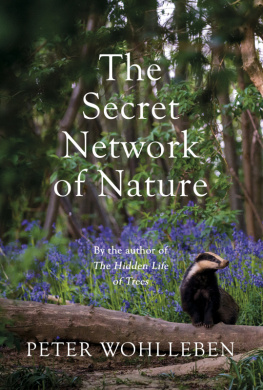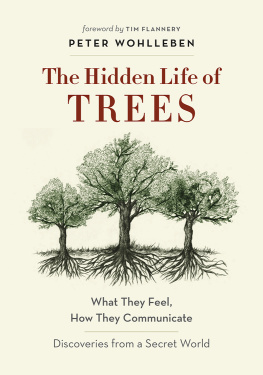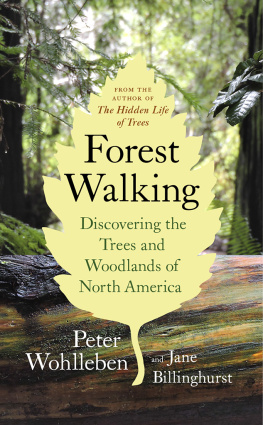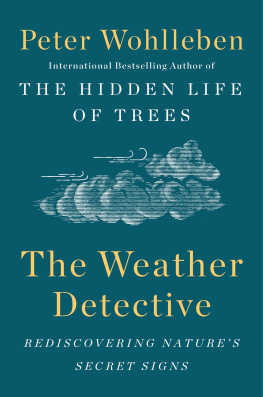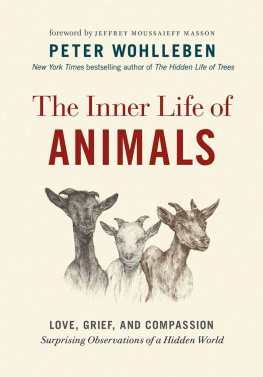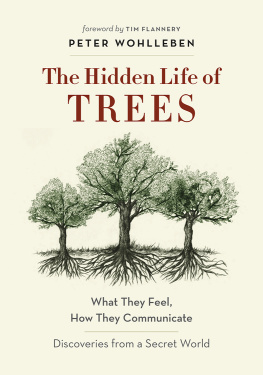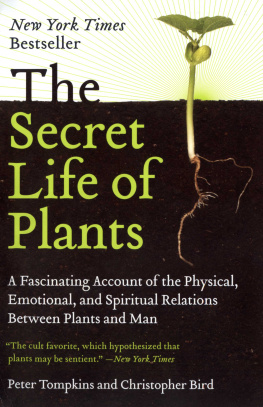Contents
About the Book
Did you know that trees can make clouds?
Or that a change in wolf population can alter the course of a river?
Or that earthworms give wild boar directions?
The natural world is a web of intricate connections, many of which go unnoticed by humans. But it is these connections that maintain natures finely balanced equilibrium, and tinkering with one tiny element can set off a chain reaction that affects an entire ecosystem.
In The Secret Network of Nature, forester and bestselling author Peter Wohlleben opens our eyes to surprising connections and unlikely partnerships in nature. Well see how different animals, plants, rivers, rocks and weather systems co-operate, and what happens when these delicate systems are unbalanced.
About the Author
Peter Wohlleben spent over twenty years working for the forestry commission in Germany before leaving to put his ideas of ecology into practice. He now runs an environmentally friendly woodland in Germany, where he is working towards the return of primeval forests, as well as caring for both wild and domestic animals.
Wohlleben has been celebrated for his distinctive approach to writing about nature; he brings to life groundbreaking scientific research through his observations of nature and the animals he lives amongst. He is also the author of international bestsellers including The Hidden Life of Trees and The Inner Life of Animals.
Also by Peter Wohlleben
The Mysteries of Nature Trilogy
The Hidden Life of Trees
The Inner Life of Animals
The Secret Network of Nature
Introduction
NATURE IS LIKE a giant clockwork mechanism. Everything is neatly arranged and interconnected. Everything has its place and its function. Take the wolf, for example. Under the order Carnivora, there is the suborder Caniformia, which includes the family Canidae and the subfamily Caninae, which includes the genus Canis, and within that genus we finally get to the species wolf. Phew. As predators, wolves keep down the number of plant eaters so that deer populations, for example, do not multiply too rapidly. All animals and plants are part of a delicate equilibrium, and every entity has its purpose and role in its ecosystem. For us humans this way of organising life supposedly gives us a clear view of the world, and thus a sense of security. As erstwhile plains dwellers, our most important sense is sight, and so our species relies on viewing things clearly. But do we really have a clear view of what is going on?
The wolves remind me of an episode from my childhood. I was about five years old and on holiday visiting my grandparents in Wrzburg when my grandfather gave me an old clock. The first thing I did was take it apart : I just couldnt wait to find out how it worked. But even though I was convinced I knew how to put it back together in working order, I discovered I couldnt. I was just a kid, after all. So after Id finished reassembling it, there were still a few cogs left over, and my grandfather was not best pleased.
In the wild, wolves are those cogs. If we eradicate them, not only do we get rid of the enemies of sheep and cattle ranchers, but the finely tuned mechanism of nature begins to run differently so differently that rivers may change course and local bird species die out.
Things can also go awry when a new species is added to a habitat: the introduction of a non-native fish, for example, can lead to a massive reduction in the local elk population. Because of a fish? The earths ecosystems, it seems, are just a bit too complex for us to compartmentalise them and draw up simple rules of cause and effect. Even conservation measures can have unexpected results. Would you expect, for example, that the recovery of crane populations in Europe affects the production of Iberian ham?
Its high time, therefore, that we took a good look at the interconnections between species both large and small. In so doing, we get the chance to meet a range of rather odd creatures, such as red-headed flies that take wing only at night in winter on the lookout for old bones, or beetles that seek out cavities in rotting trees, where they dine on the feathery remains of pigeons and owls (but only when theyre mixed together). The more light you shed on relationships between species, the more fascinating facts you discover.
But nature is much more complex than a clock. In nature, not only does one cog connect with another: everything is connected in a network so intricate that we will probably never grasp it in its entirety. And that is a good thing, because it means that plants and animals will continue to amaze us. Its important for us to realise that even small interventions in nature can have huge consequences, and wed better keep our hands off anything that we have no pressing reason to touch.
So for you to get a clearer picture of this intricate network, Id like to show you some examples. Lets be amazed together.
1
Of Wolves, Bears and Fish
WOLVES ARE A wonderful example of how complex the connections in nature can be. For amazingly enough, these predators are able to reshape riverbanks and change the course of rivers.
This is what happened in Yellowstone, the very first national park in the United States. In the nineteenth century, people began to systematically eradicate wolves in the park, primarily in response to pressure from ranchers in the surrounding area, who were worried about their grazing livestock. The last pack was wiped out in 1926. Individual wolves continued to be spotted occasionally until the 1930s, when they, too, were eliminated. Other animals living in the park werent harmed; on the contrary, some were actually looked after. In harsh winters, for example, rangers even went as far as feeding the elk.
It wasnt long before the consequences became clear. No sooner was the pressure from predators lifted than elk populations began to increase steadily, and large areas of the park were stripped bare by the voracious animals. Riverbanks were particularly hard hit. The juicy grass by the river disappeared, along with all the saplings growing there. Now this desolate landscape didnt provide enough food even for birds, and the number of species declined drastically. Beavers were among the losers, because they depend not only on water but also on the trees that grow by the river willows and poplars are some of their favourite foods. They cut them down so they can get at the trees nutrient-rich new growth, which they devour with relish. Because all the young deciduous trees alongside the water were ending up in the stomachs of hungry elk, the beavers had nothing to gnaw on, and they disappeared.
Riverbanks became wastelands, and without any vegetation to protect the ground, seasonal flooding washed away ever-increasing quantities of soil. Erosion advanced rapidly. As a result, the rivers began to meander more and follow increasingly winding paths through the landscape. And the less protection from erosion for the underlying layers of soil, the more pronounced that serpentine tendency, especially in a flat landscape.

